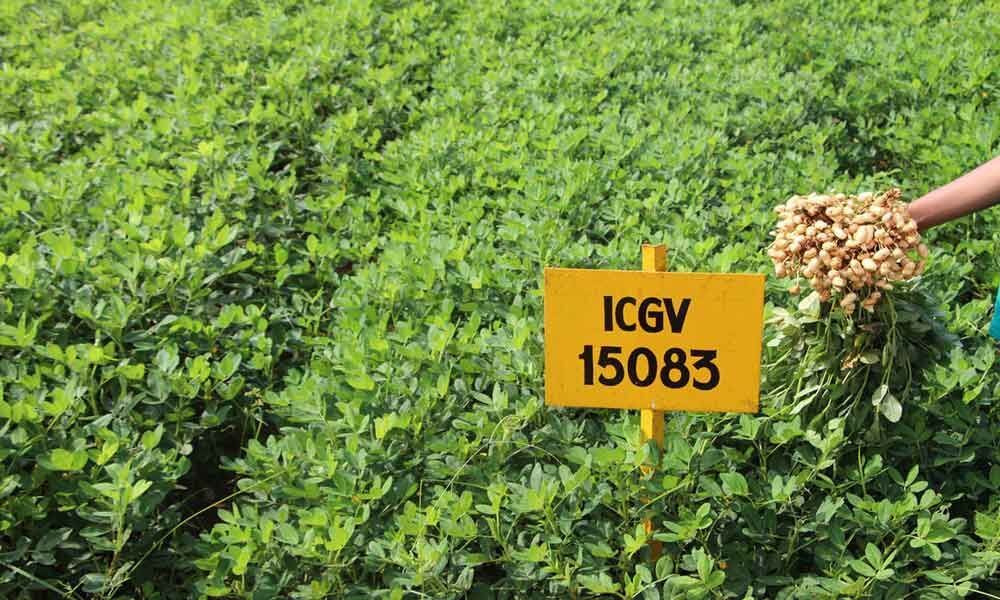Live
- CERT-In Warns iPhone Users: Update to iOS 18.1.1 Now to Avoid Hacking
- Rana Daggubati’s Show gets huge applause at 55th IFFI
- Jana Sena MLA Pulaparthi Ramanjaneyulu Elected as PAC chairman
- Stage set for counting of votes for Jharkhand Assembly elections
- MLA Sri Ganesh Engages ASHA Workers and Resource Persons in Caste Census Meeting
- Supreme Court verdict on validity of Preamble modification in 1976 likely on November 25
- ‘Zebra’ movie review: A gripping tale of banking fraud and redemption
- Saurabh Netravalkar, Unmukt Chand, Dwayne Smith and Rahkeem Cornwall headline USPL
- NPP asks members not to attend meeting called by Biren govt
- Bulls roar on Dalal Street, Sensex and Nifty up over 2 pc
Just In

After eight years of collaborative work, two high oleic groundnut lines have been identified by India’s coordinated release program to go commercial. This means processors and consumers in India will now have access to healthier groundnut-based food products and oil with longer shelf life.
Patancheru: After eight years of collaborative work, two high oleic groundnut lines have been identified by India's coordinated release program to go commercial. This means processors and consumers in India will now have access to healthier groundnut-based food products and oil with longer shelf life.
Oleic acid is a monounsaturated fatty acid with health benefits including reduced risk of developing cardiovascular diseases. It is preferred to normal groundnut oil and products such as confectionaries, flour, cake and butter etc., as studies show that high oleic groundnut oil and products are less prone to oxidation, hence giving extended shelf-life.
This first commercialisation of high oleic groundnut varieties in India meets food industry and consumer needs for longer shelf life and improved health benefits. Announcing this decision, Dr Radhakrishnan, Director, Indian Council of Agricultural Research (ICAR)-Directorate of Groundnut Research (ICAR-DGR) says, "At the Annual Groundnut Workshop held during 25-27 May 2019, the Variety Identification Committee identified two varieties, Girnar 4 (ICGV 15083) and Girnar 5 (ICGV 15090) with about 80% oleic acid content to release for cultivation in India.
The recommendation by the Committee was based on multi-location testing conducted under the All-India Co-ordinated Research Project on Groundnut (AICRP-G) during 2017 and 2018." The AICRP-G is a Government of India-led, multi-institutional research collaboration of multi-disciplinary teams across the ICAR-DGR, State Agricultural Universities and ICRISAT.
The two high oleic groundnut lines identified for release have kernel oleic acid content of about 80% (of total fat content) as against 40-50% in the normal groundnut kernels. It reduces low-density lipoprotein (LDL) cholesterol (considered 'bad' cholesterol) and maintains high-density lipoproteins (HDL) levels or 'good' cholesterol, making them far healthier.
"This is an exciting phase of groundnut breeding in India," said Dr Peter Carberry, Director General, ICRISAT. "Food processing industries in the USA and Australia have successfully tapped the potential of high oleic groundnuts and actors across the value chains benefited. Argentina exploited high oleic groundnut through high-value exports. With food processors keen to source high oleic groundnuts from India for shelf-life benefits, this release can benefit many segments including farmers."
Multi-season and site testing since 2014 have shown that the agronomic performance of the high oleic lines is significantly superior to the local popular varieties. ICGV 15090 and 15083 recorded 46% and 42% higher pod yield, respectively than the national check, TG 37 A.
Dr Janila Pasupuleti, Principal Groundnut Breeder, and leader of the groundnut breeding team at ICRISAT, attributes the success to partnerships and the financial assistance from the National Mission for Oilseeds and Oil Palm (NMOOP) of Department of Agriculture, Co-operation and Farmers' Welfare (DoAC & FW), GoI.
Dr Kiran Sharma, Deputy Director General-Research, ICRISAT, and Director, CGIAR Research Program on Grain Legumes and Dryland Cereals (CRP-GLDC), noted that the commercialisation of high oleic groundnut varieties is an example of market-oriented crop breeding that results in benefits to all value chain actors including smallholder farmers. He reiterated that the way forward is a closed loop value chain for high oleic groundnuts to ensure high genetic purity of seed supplied to farmers for high quality to meet the standards of processors.
The breeding work was supported by ICRISAT's Genetic Gains research program and partners. Genomic tools that enabled early generation selection, wherein molecular markers developed at University of Georgia, USA for two FAD (Fatty Acid Desaturase) mutant alleles were used in Marker Assisted Breeding to develop high oleic groundnut lines.
The linked allele-specific and cleaved amplified polymorphic sequences (CAPS) markers for both the mutant alleles were used in the breeding. Robust, non-destructive, and cost-effective evaluation using Near Infrared Reflectance Spectroscopy enabled the identification of 'high oleic' groundnut lines in Spanish and Virginia Bunch background. The fast-track development, testing and advancement were possible through use of low-cost controlled conditions for reducing generation interval, early generation and multi-location testing.
The partners in this effort in India include: Indian Council of Agriculture Research - Directorate of Groundnut Research (ICAR-DGR), Junagadh; Main Oilseeds Research Station, Junagadh Agricultural University, Junagadh; Tamil Nadu Agricultural University, Coimbatore; and Regional Agricultural Research Station, ANGRAU, Tirupati; Regional Agricultural Research Station, PJTSAU, Palem.

© 2024 Hyderabad Media House Limited/The Hans India. All rights reserved. Powered by hocalwire.com







